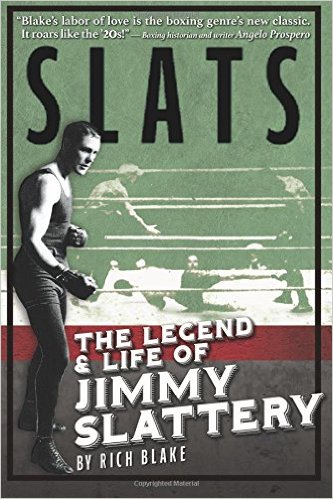From the Bookshelf: ‘Slats’ recounts life of Jimmy Slattery

 “Slats: The Legend and Life of Jimmy Slattery” by Rich Blake (NFB/Amelia Press) is about a fighter and an era when local fighters were heroes, the good-looking ones were matinee idols, and boxing mattered.
“Slats: The Legend and Life of Jimmy Slattery” by Rich Blake (NFB/Amelia Press) is about a fighter and an era when local fighters were heroes, the good-looking ones were matinee idols, and boxing mattered.
Slattery was born in Buffalo in 1904. He turned pro at age 17, won his first 38 fights, lost a six-round decision, and reeled off 10 more wins before manager Red Carr inadvisedly matched him against world middleweight champion Harry Greb, who beat him badly. Slattery was 20 years old at the time.
“Slats,” Blake writes, “was a comet, the rage of the nation. Never was anyone so assuredly fated for ring supremacy. Slats more resembled a silent movie star than a pugilist. He fought in a fast fluid unique manner – arms dangling loose at his sides, dancing on his toes, avoiding punches with a deft tilt of his head before snapping his right like a cobra. Considered so far above everyone else in the game, Slattery drew comparisons to Man O’ War. When he fought at Yankee Stadium, Babe Ruth sat ringside.”
But by 1927, Slattery was an alcoholic. He partied before fights and, once he lost, after them.
“He sold his boxing birthright for a mess of good times,” Ed Hughes of the New York Telegraph wrote.
“He was washed up at 24,” Blake acknowledges.
In the last major fight of his career, Slattery fought Maxie Rosenbloom for the seventh time (a 15-round-decision loss at Ebbet’s Field in Brooklyn). The action, or lack thereof, was so abysmal that Westbrook Pegler wrote in the Chicago Tribune, “Rosenbloom won and Slattery lost, but the patrons took the punishment.” The Police Gazette added, “The 5,000 fans would probably have gotten more thrills had they gone instead to the Brooklyn Botanical Garden across the street.”
Slattery retired at age 29 with a ring record of 111 wins, 13 losses, 49 KOs and 4 KOs by. Asked to put his career in perspective, boxing historian Craig Hamilton told this writer, “He was a good fighter and a hot prospect when he was young. But he was poorly matched and never developed into a championship-caliber fighter. He fought a lot of tough guys: Harry Greb, Young Stribling, Jack Delaney, Dave Shade, Paul Berlenbach, Maxie Rosenbloom, Tommy Loughran, James Braddock, King Levinsky. And for the most part, he fought them at the wrong time. What he really needed was a guy like Bruce Trampler to matchmake for him.”
On a personal level, Slattery married, had a son, walked away from the marriage (which ended in divorce), and saw his son roughly 20 times during the course of his life. After boxing, he was arrested countless times for public intoxication, driving while intoxicated, and other alcohol-related offenses in addition to at least one robbery. He lived in flophouses and was homeless for a time. He never stopped drinking.
“Slats” is thoroughly researched and well-written with an eye for detail. It’s a bit hyperbolic at times, as evidenced by the book’s opening sentence that maintains “no boxer [in the mid-1920s] transfixed fans like Jimmy Slattery” and a later chapter that calls him “the most talked about boxer on the planet.” Outside of Buffalo, those who were familiar with Jack Dempsey might have disputed that notion.
Dempsey himself makes several appearances in the book, including an anecdote that dates to 1925 when the Manassa Mauler (still heavyweight champion) appeared on the vaudeville circuit in Buffalo.
Ike O’Neil, a Buffalo-born trainer, came by the theater to say hello.
“Remember this fellow?” Dempsey was asked.
“Aren’t you the fellow who worked in Willard’s corner that day?” Dempsey answered, harkening back to July 4, 1919, when he beat Jess Willard to a bloody pulp and claimed the heavyweight throne.
“Yeah, that’s me,” O’Neil told the champ. “I’m the guy who threw in the towel.”
“Jess stayed in the game too long,” Dempsey responded, a reference to the knockout loss that Willard suffered at the hands of Luis Firpo four years later. “When I lose the title, I’m done. They’re not going to make a punching bag out of Jack Dempsey.”
And there’s an entertaining bit of boxing lore in Blake’s recounting of a 1956 television appearance in which Maxie Rosenbloom told an interviewer, “I fought Jimmy Slattery [three times] in Buffalo and beat him every time, but I was robbed on hometown decisions. I saw it was hopeless trying to beat him in Buffalo and I decided to make some money out of losing. So [in our 1930 fight] I bet $5,000 on Slats. Along about the fourth round with neither of us doing anything, I said to Jimmy, ‘Come on, Slats, do something. I bet on you to win.’ And Slats said, ‘I bet on you.'”
Claiming that he’d been falsely defamed, Slattery sued Rosenbloom, CBS, and Gillette (which had sponsored the telecast) for $500,000. The case was settled for five hundred dollars.
Thomas Hauser can be reached by email at [email protected]. His next book (“A Hurting Sport: An Inside Look at Another Year in Boxing”) will be published later this year by the University of Arkansas Press.















